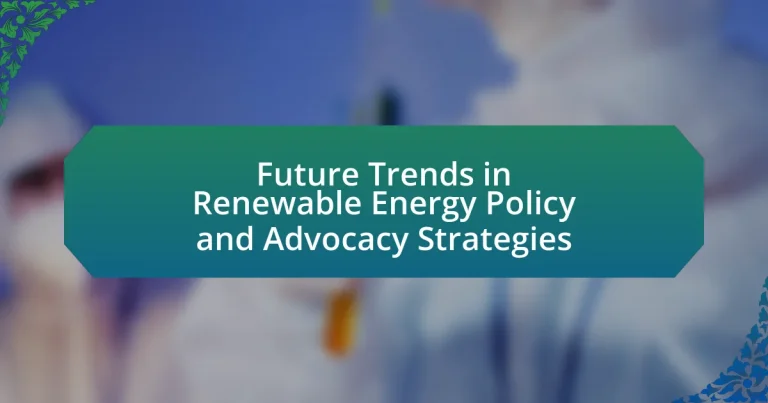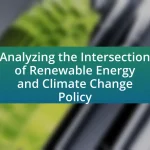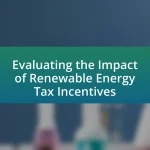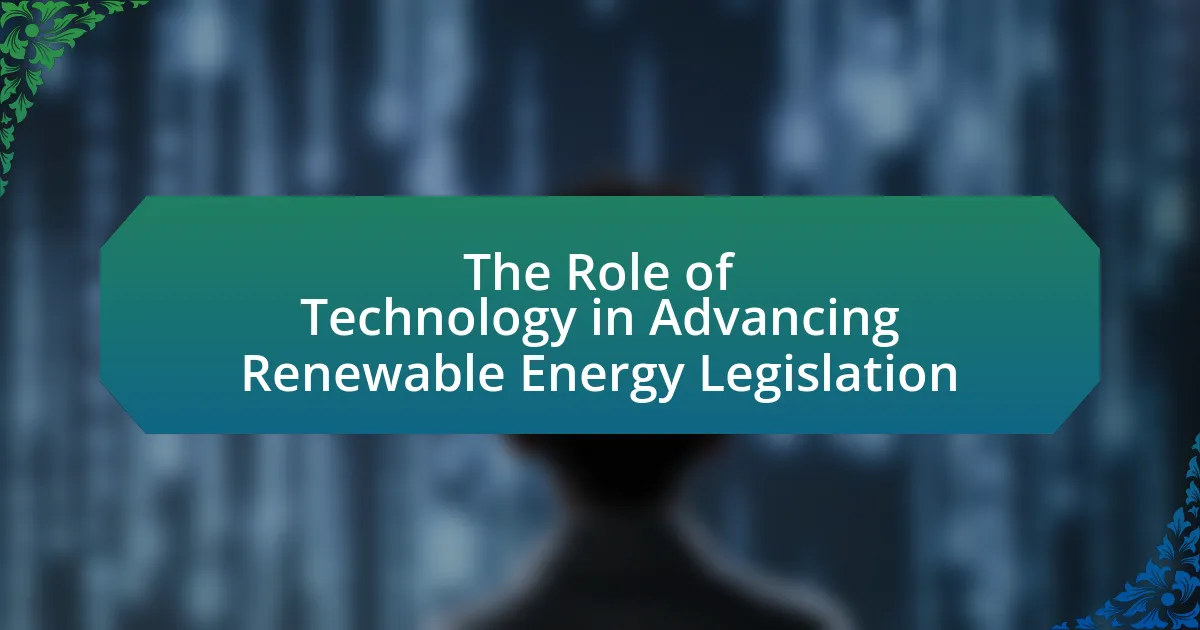The article focuses on future trends in renewable energy policy and advocacy strategies, highlighting the integration of technology, collaboration among stakeholders, and a commitment to equity in energy transitions. It discusses the evolution of global policies supporting renewable energy, influenced by international agreements such as the Paris Agreement and the Sustainable Development Goals. The article also examines the varying approaches of national policies, the role of advocacy strategies in shaping legislation, and the importance of public awareness and grassroots movements in promoting renewable energy initiatives. Additionally, it addresses the challenges faced by policymakers and the significance of stakeholder collaboration in enhancing renewable energy policies.

What are the Future Trends in Renewable Energy Policy and Advocacy Strategies?
Future trends in renewable energy policy and advocacy strategies include increased integration of technology, enhanced collaboration among stakeholders, and a focus on equity and justice in energy transitions. Policymakers are increasingly leveraging digital tools and data analytics to optimize energy systems and improve decision-making processes. Collaborative efforts among governments, private sectors, and civil society are becoming essential to drive comprehensive energy policies that address climate change effectively. Furthermore, there is a growing emphasis on ensuring that renewable energy transitions are equitable, addressing the needs of marginalized communities and ensuring access to clean energy for all. These trends are supported by global commitments such as the Paris Agreement, which emphasizes the need for inclusive and sustainable energy policies.
How are global policies evolving to support renewable energy?
Global policies are evolving to support renewable energy through increased commitments to carbon neutrality, financial incentives, and international cooperation. Countries are setting ambitious targets, such as the European Union’s goal of achieving net-zero emissions by 2050, which drives investments in renewable technologies. Financial mechanisms, including subsidies and tax credits, are being implemented to lower the cost of renewable energy projects, as seen in the United States with the Investment Tax Credit for solar energy. Additionally, international agreements like the Paris Agreement foster collaboration among nations to share technology and best practices, enhancing the global transition to renewable energy sources.
What international agreements are influencing renewable energy policies?
International agreements influencing renewable energy policies include the Paris Agreement, the United Nations Framework Convention on Climate Change (UNFCCC), and the Sustainable Development Goals (SDGs). The Paris Agreement, adopted in 2015, aims to limit global warming to well below 2 degrees Celsius, prompting countries to enhance their renewable energy commitments. The UNFCCC, established in 1992, provides a framework for international cooperation on climate change, encouraging nations to adopt policies that promote renewable energy. Additionally, the SDGs, particularly Goal 7, emphasize the importance of ensuring access to affordable, reliable, sustainable, and modern energy for all, further driving the adoption of renewable energy policies globally.
How do national policies differ in their approach to renewable energy?
National policies differ significantly in their approach to renewable energy based on factors such as government priorities, economic conditions, and technological capabilities. For instance, countries like Germany have implemented aggressive feed-in tariff systems that guarantee fixed payments for renewable energy producers, promoting solar and wind energy development. In contrast, the United States has a more decentralized approach, with states like California leading in renewable energy initiatives while others may prioritize fossil fuels. Additionally, China has made substantial investments in renewable technologies, becoming the largest producer of solar panels, driven by government mandates and subsidies. These variations illustrate how national policies are shaped by local contexts and strategic goals, impacting the pace and scale of renewable energy adoption globally.
What role do advocacy strategies play in shaping renewable energy policies?
Advocacy strategies play a crucial role in shaping renewable energy policies by mobilizing public support, influencing decision-makers, and promoting sustainable practices. These strategies often involve grassroots campaigns, lobbying efforts, and partnerships with stakeholders to raise awareness about the benefits of renewable energy. For instance, organizations like the Sierra Club have successfully advocated for policies that promote solar and wind energy, leading to legislative changes in various states. Research indicates that effective advocacy can lead to increased funding for renewable projects and the implementation of supportive regulations, thereby accelerating the transition to cleaner energy sources.
How can grassroots movements impact renewable energy legislation?
Grassroots movements can significantly influence renewable energy legislation by mobilizing public support and advocating for policy changes. These movements often raise awareness about environmental issues, engage communities, and pressure lawmakers to prioritize renewable energy initiatives. For instance, the Sierra Club’s “Ready for 100” campaign successfully pushed several cities and states to commit to 100% renewable energy by demonstrating widespread public backing and organizing local actions. This grassroots pressure can lead to the introduction of new legislation, amendments to existing laws, and increased funding for renewable energy projects, as evidenced by the rapid adoption of renewable energy targets in various jurisdictions following grassroots advocacy efforts.
What are the most effective advocacy techniques for promoting renewable energy?
The most effective advocacy techniques for promoting renewable energy include grassroots mobilization, policy engagement, and strategic partnerships. Grassroots mobilization involves organizing community members to raise awareness and support for renewable energy initiatives, which can lead to increased public demand and political pressure. Policy engagement focuses on directly influencing lawmakers and regulatory bodies through lobbying efforts, providing data-driven arguments, and participating in public consultations to shape favorable legislation. Strategic partnerships with businesses, NGOs, and academic institutions can amplify advocacy efforts by pooling resources, expertise, and networks, thereby enhancing the credibility and reach of renewable energy campaigns. These techniques have been shown to successfully drive policy changes and increase investment in renewable energy, as evidenced by the significant growth in renewable energy adoption in regions with strong advocacy movements, such as California and Germany.
Why is public awareness crucial for renewable energy policy changes?
Public awareness is crucial for renewable energy policy changes because it drives public support and engagement, which are essential for effective policy implementation. When the public is informed about the benefits of renewable energy, such as reduced greenhouse gas emissions and energy independence, they are more likely to advocate for policies that promote these technologies. Research indicates that increased public awareness can lead to higher levels of political action and influence on decision-makers, as seen in various campaigns that successfully pushed for renewable energy initiatives in countries like Germany and Denmark. These examples demonstrate that informed citizens can significantly impact the legislative process, making public awareness a key factor in advancing renewable energy policies.
How does public perception influence renewable energy initiatives?
Public perception significantly influences renewable energy initiatives by shaping policy decisions and funding allocations. When the public views renewable energy positively, it encourages governments and organizations to invest in and promote these technologies. For instance, a 2021 survey by the Pew Research Center found that 79% of Americans support expanding solar panel farms, which directly impacts legislative efforts to increase funding and incentives for solar energy projects. Conversely, negative public perception can lead to reduced support for renewable initiatives, as seen in regions where local opposition has stalled wind farm developments. Thus, public sentiment acts as a critical driver for the advancement and implementation of renewable energy policies.
What strategies can be employed to enhance public engagement in renewable energy issues?
To enhance public engagement in renewable energy issues, strategies such as community education programs, participatory decision-making, and leveraging social media platforms can be employed. Community education programs, like workshops and informational sessions, increase awareness and understanding of renewable energy benefits, evidenced by studies showing that informed communities are more likely to support renewable initiatives. Participatory decision-making involves stakeholders in the planning and implementation of renewable projects, fostering a sense of ownership and commitment, as demonstrated by successful local energy projects in Germany. Additionally, utilizing social media platforms for outreach and engagement allows for real-time interaction and dissemination of information, which has been shown to significantly increase public interest and involvement in energy discussions.
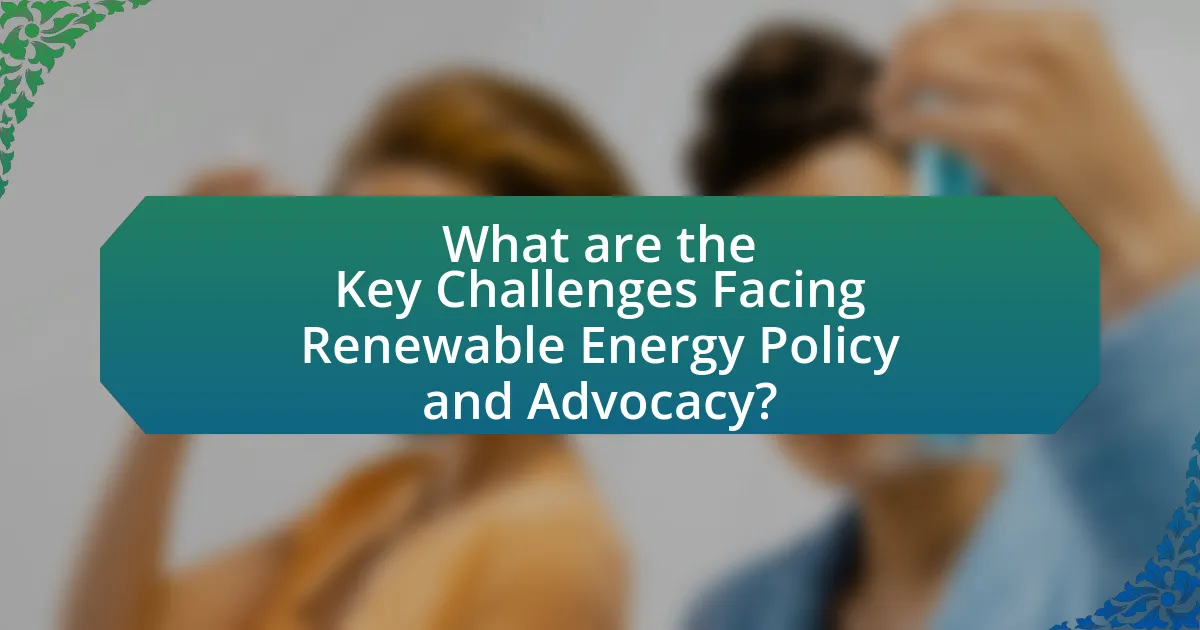
What are the Key Challenges Facing Renewable Energy Policy and Advocacy?
The key challenges facing renewable energy policy and advocacy include regulatory hurdles, financial constraints, and public acceptance issues. Regulatory hurdles often arise from outdated policies that do not accommodate new technologies, making it difficult for renewable energy projects to gain approval. Financial constraints are significant, as many renewable energy initiatives require substantial upfront investment, which can deter stakeholders. Public acceptance issues stem from a lack of awareness or misinformation about renewable energy benefits, leading to resistance against projects in local communities. These challenges hinder the effective implementation and expansion of renewable energy initiatives, as evidenced by studies showing that regions with supportive policies and public engagement see higher adoption rates of renewable technologies.
What obstacles do policymakers encounter in implementing renewable energy strategies?
Policymakers encounter several obstacles in implementing renewable energy strategies, including financial constraints, regulatory challenges, and public opposition. Financial constraints arise from the high initial capital costs associated with renewable energy projects, which can deter investment. Regulatory challenges often stem from outdated policies and bureaucratic hurdles that complicate the approval process for new technologies. Public opposition can manifest in the form of NIMBY (Not In My Backyard) sentiments, where communities resist local renewable energy installations due to perceived negative impacts on their environment or property values. These obstacles hinder the transition to renewable energy and require targeted strategies to overcome them.
How do economic factors affect renewable energy policy development?
Economic factors significantly influence renewable energy policy development by determining the financial viability and attractiveness of renewable technologies. For instance, fluctuations in fossil fuel prices can make renewable energy sources more or less competitive; when fossil fuel prices rise, renewable energy becomes more appealing, prompting governments to implement supportive policies. Additionally, investment levels in renewable energy are often tied to economic conditions; during economic downturns, funding for renewable projects may decrease, leading to slower policy advancements. According to the International Renewable Energy Agency (IRENA), global investment in renewable energy reached $300 billion in 2020, highlighting the correlation between economic conditions and policy support. Thus, economic factors shape the pace and direction of renewable energy policy development through market competitiveness and investment trends.
What role does technology play in overcoming policy challenges?
Technology plays a crucial role in overcoming policy challenges by providing innovative solutions that enhance efficiency, transparency, and stakeholder engagement. For instance, data analytics and modeling tools enable policymakers to assess the impacts of renewable energy initiatives more accurately, leading to informed decision-making. Additionally, blockchain technology can improve transparency in energy transactions, thereby fostering trust among stakeholders. A study by the International Renewable Energy Agency (IRENA) highlights that digital technologies can reduce costs and improve the integration of renewable energy sources into existing grids, addressing regulatory hurdles effectively.
How can advocacy groups address resistance to renewable energy policies?
Advocacy groups can address resistance to renewable energy policies by employing targeted education and outreach strategies. These groups can provide clear, evidence-based information about the benefits of renewable energy, such as its potential to reduce greenhouse gas emissions and create jobs; for instance, the International Renewable Energy Agency reported that the renewable energy sector employed over 11 million people globally in 2018. Additionally, advocacy groups can engage with local communities to understand their concerns and tailor messages that resonate with specific audiences, thereby fostering trust and collaboration. By utilizing social media campaigns and public forums, these groups can amplify their message and counter misinformation, which has been shown to significantly influence public perception and acceptance of renewable energy initiatives.
What strategies can be used to counter misinformation about renewable energy?
To counter misinformation about renewable energy, strategies include promoting accurate information through education, utilizing social media campaigns, and engaging with community leaders. Education initiatives can provide factual data about renewable energy benefits, such as the International Renewable Energy Agency reporting that renewable energy could provide 24 million jobs globally by 2030. Social media campaigns can effectively reach a broad audience, as studies show that targeted messaging can significantly reduce the spread of false information. Engaging community leaders fosters trust and encourages local discussions that can dispel myths, as evidenced by successful grassroots movements that have shifted public perception in favor of renewable energy initiatives.
How can coalitions strengthen advocacy efforts for renewable energy?
Coalitions can strengthen advocacy efforts for renewable energy by uniting diverse stakeholders to amplify their collective voice and influence policy decisions. By combining resources, expertise, and networks, coalitions enhance their ability to mobilize public support and engage with policymakers effectively. For instance, the Renewable Energy Buyers Alliance, which includes major corporations and NGOs, has successfully advocated for policies that promote renewable energy adoption, demonstrating the power of collaborative efforts in shaping energy policy.
What are the implications of political changes on renewable energy advocacy?
Political changes significantly impact renewable energy advocacy by altering funding, regulatory frameworks, and public support for clean energy initiatives. For instance, when governments shift towards pro-renewable policies, such as the implementation of subsidies or tax incentives, advocacy efforts gain momentum, leading to increased investment in renewable technologies. Conversely, political shifts towards fossil fuel interests can result in reduced funding and support for renewable projects, as seen in the U.S. during the transition from the Obama administration to the Trump administration, which saw a rollback of renewable energy incentives. These dynamics illustrate how political landscapes directly influence the effectiveness and direction of renewable energy advocacy efforts.
How do shifts in government leadership affect renewable energy initiatives?
Shifts in government leadership significantly impact renewable energy initiatives by altering policy priorities, funding allocations, and regulatory frameworks. For instance, when a government transitions to leadership that prioritizes environmental sustainability, there is often an increase in investment in renewable technologies, as seen during the Obama administration in the United States, which implemented the Clean Power Plan and expanded tax incentives for solar and wind energy. Conversely, leadership that favors fossil fuel industries may reduce support for renewables, as evidenced by the Trump administration’s rollback of various environmental regulations and withdrawal from the Paris Agreement, which hindered renewable energy progress. These changes in leadership can lead to fluctuations in market confidence and investment in renewable energy sectors, directly affecting their growth and development.
What can advocacy groups do to adapt to changing political landscapes?
Advocacy groups can adapt to changing political landscapes by employing flexible strategies that respond to shifts in policy priorities and public sentiment. These groups should continuously monitor political developments and engage in data-driven analysis to identify emerging trends, allowing them to pivot their messaging and tactics accordingly. For instance, during the transition to a more favorable political environment for renewable energy, advocacy groups can leverage public opinion data showing increased support for clean energy initiatives, as evidenced by a 2021 Pew Research Center survey indicating that 79% of Americans favor expanding solar panel farms. By aligning their campaigns with these shifts, advocacy groups can effectively influence policy decisions and mobilize grassroots support.
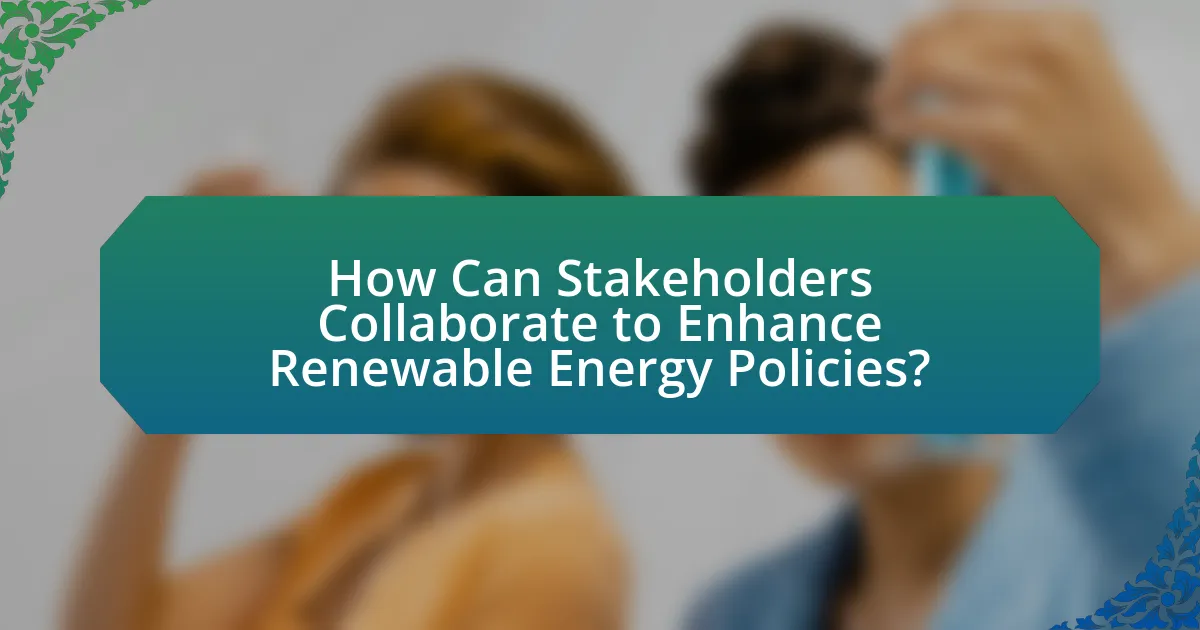
How Can Stakeholders Collaborate to Enhance Renewable Energy Policies?
Stakeholders can collaborate to enhance renewable energy policies by forming multi-sector partnerships that leverage diverse expertise and resources. These collaborations can include government agencies, private companies, non-profit organizations, and community groups working together to create comprehensive policy frameworks. For instance, the International Renewable Energy Agency (IRENA) emphasizes the importance of stakeholder engagement in policy development, highlighting that inclusive dialogue leads to more effective and widely accepted policies. Additionally, joint initiatives such as public-private partnerships can facilitate investment in renewable technologies, as seen in the European Union’s Green Deal, which aims to mobilize over €1 trillion in sustainable investments. By sharing knowledge, aligning goals, and pooling financial resources, stakeholders can drive innovation and accelerate the transition to renewable energy.
What partnerships are essential for advancing renewable energy initiatives?
Collaborations between government entities, private sector companies, non-profit organizations, and academic institutions are essential for advancing renewable energy initiatives. These partnerships facilitate resource sharing, innovation, and the implementation of effective policies. For instance, government incentives can stimulate private investment in renewable technologies, while non-profits can advocate for sustainable practices and raise public awareness. Academic institutions contribute research and development, leading to technological advancements. According to the International Renewable Energy Agency, effective partnerships can accelerate the deployment of renewable energy solutions, demonstrating their critical role in achieving global sustainability goals.
How can public-private partnerships drive renewable energy innovation?
Public-private partnerships can drive renewable energy innovation by combining resources, expertise, and risk-sharing between government entities and private companies. These collaborations facilitate the development of cutting-edge technologies and infrastructure, as evidenced by initiatives like the U.S. Department of Energy’s SunShot Initiative, which aims to reduce solar energy costs through partnerships with private firms. Such partnerships leverage public funding to attract private investment, accelerating research and deployment of renewable energy solutions. Additionally, they foster regulatory frameworks that encourage innovation, as seen in various countries where government incentives have spurred private sector advancements in wind and solar technologies.
What role do non-governmental organizations play in policy advocacy?
Non-governmental organizations (NGOs) play a crucial role in policy advocacy by influencing decision-makers and shaping public policy through research, awareness campaigns, and grassroots mobilization. NGOs often conduct studies that highlight the impacts of energy policies, providing data that supports sustainable practices and renewable energy initiatives. For instance, organizations like Greenpeace and the World Wildlife Fund have successfully lobbied for renewable energy legislation by presenting evidence of climate change and advocating for cleaner energy sources. Their efforts have led to significant policy changes, such as the adoption of renewable energy targets in various countries, demonstrating the effectiveness of NGO advocacy in driving policy reform.
How can local communities influence renewable energy policy development?
Local communities can influence renewable energy policy development by actively participating in decision-making processes and advocating for local needs and preferences. Their involvement can take the form of public consultations, community meetings, and partnerships with local governments, which allow them to express their views on renewable energy projects. For instance, studies have shown that when communities engage in the planning stages of renewable energy initiatives, such as wind or solar farms, they can significantly shape project outcomes, leading to policies that reflect local priorities and concerns. This influence is further supported by evidence indicating that community-led initiatives often result in higher acceptance rates and successful implementation of renewable energy projects, as seen in various case studies across Europe and North America.
What are the benefits of community-led renewable energy projects?
Community-led renewable energy projects provide numerous benefits, including increased local energy independence, economic development, and enhanced community engagement. These projects empower communities to generate their own energy, reducing reliance on external sources and fostering resilience against energy price fluctuations. Economically, they create jobs and stimulate local economies by investing in renewable technologies and infrastructure. Furthermore, community involvement in energy decision-making fosters a sense of ownership and responsibility, leading to greater public support for sustainable practices. Studies have shown that communities with such projects often experience improved social cohesion and environmental awareness, contributing to long-term sustainability goals.
How can local governments support renewable energy advocacy efforts?
Local governments can support renewable energy advocacy efforts by implementing policies that promote clean energy initiatives and providing funding for renewable projects. For instance, local governments can establish incentives such as tax credits or grants for residents and businesses that invest in solar panels or wind energy systems. According to the National Renewable Energy Laboratory, local policies that support renewable energy can lead to a 20% increase in renewable energy installations within communities. Additionally, local governments can facilitate community engagement through public forums and educational programs, raising awareness about the benefits of renewable energy and encouraging public participation in advocacy efforts.
What best practices can stakeholders adopt for effective collaboration?
Stakeholders can adopt several best practices for effective collaboration, including establishing clear communication channels, defining roles and responsibilities, and fostering a culture of trust and respect. Clear communication channels ensure that all parties are informed and aligned on objectives, which is crucial in the context of renewable energy policy where diverse interests must be reconciled. Defining roles and responsibilities helps to avoid overlap and confusion, allowing stakeholders to focus on their specific contributions. Fostering a culture of trust and respect encourages open dialogue and collaboration, which is essential for addressing complex challenges in renewable energy advocacy. Research indicates that organizations with strong collaborative practices are more successful in achieving their goals, as evidenced by a study published in the Journal of Cleaner Production, which found that effective stakeholder engagement significantly enhances project outcomes in renewable energy initiatives.
How can communication strategies enhance stakeholder engagement?
Communication strategies enhance stakeholder engagement by fostering transparency, building trust, and facilitating two-way dialogue. Effective communication ensures that stakeholders are informed about policies, initiatives, and changes, which increases their involvement and investment in the process. For instance, research by the International Renewable Energy Agency (IRENA) indicates that clear communication of renewable energy benefits leads to higher public support and participation in energy projects. By utilizing tailored messaging and diverse communication channels, organizations can address stakeholder concerns and feedback, ultimately leading to more collaborative and effective decision-making in renewable energy policy.
What tools are available for measuring the impact of collaborative efforts?
Tools available for measuring the impact of collaborative efforts include surveys, performance metrics, and social network analysis software. Surveys can gauge participant satisfaction and perceived effectiveness, while performance metrics track specific outcomes such as energy savings or policy changes resulting from collaboration. Social network analysis software, like Gephi or NodeXL, visualizes relationships and interactions among stakeholders, providing insights into the strength and quality of collaborative networks. These tools collectively enable organizations to assess the effectiveness of their collaborative initiatives in the context of renewable energy policy and advocacy strategies.
What practical steps can individuals take to advocate for renewable energy?
Individuals can advocate for renewable energy by engaging in community initiatives, supporting policy changes, and educating others about its benefits. Participating in local environmental groups or campaigns can amplify their voice and influence decision-makers. Supporting legislation that promotes renewable energy, such as tax incentives for solar installations, can lead to broader adoption. Additionally, sharing information through social media or community workshops can raise awareness and encourage others to consider renewable options. According to a 2021 report by the International Renewable Energy Agency, public support for renewable energy can significantly impact policy outcomes, demonstrating the effectiveness of grassroots advocacy.
